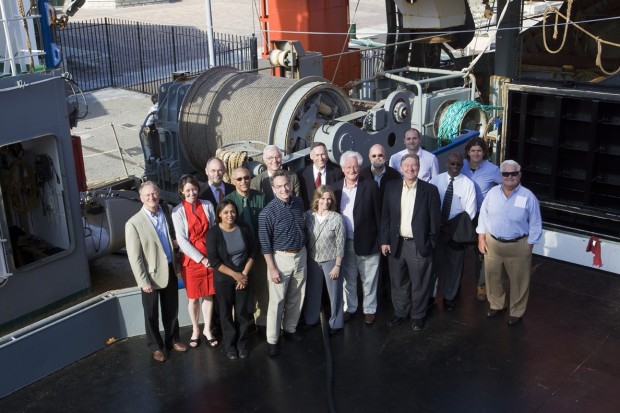Overseas Eel Research Ship Visits Bermuda
Last weekend saw the arrival of a few separate groups of individuals interested in the Sargasso Sea and its inhabitants.
On Saturday the Walther Herwig III docked in St. George’s carrying a group of overseas scientists, led by Dr. Reinhold Hanel, who were on their way to map the spawning grounds of the European eel [scientific name: Anguilla anguilla], which are now believed to migrate to the Sargasso Sea to spawn.
The European eel is a ‘catadromous’ fish – that is, it spawns and is born at sea, and then migrates into inland waters to eat and grow. In the course of its life, it travels many thousands of miles, and passes through a number of very different stages, marked by changes in their colour.
European eels can live for over 80 years and reach up to 130cm in length, but average length of adults is around 60-80 cm, when they weigh around 1-2 kg.
The last twenty years have seen a dramatic decline in the number of eels reaching European river systems, which have fallen to as little as 1% of their previous levels according to some estimates. No one explanation can account for this phenomenon, which has been seen all over Europe. Possible causes, in addition to overfishing, include parasites, the damming of river systems for hydro-electric power, pollution, and changes to the course of the Gulf Stream
In 2007, the EU adopted measures to bring about the recovery of the eel stock. As a result, eel fisheries are now managed under long-term plans drawn up by the EU countries at river-basin level.
“The eel is commercially important in Europe (and Japan where it is a delicacy),” explained Senior Marine Resources Officer Dr. Tammy Trott. “Their skins are also used to make fine leather for shoes, belts and wallets. However, their numbers have significantly declined and the European eel is now considered critically endangered.”
Conservation Services staff have been attempting to capture eels from the Pembroke Canal so that Dr. Hanel can confirm whether they are European eels or, American eels, which look very similar and also spawn in the Sargasso Sea. Although their efforts to capture a sample were unsuccessful this time efforts will continue to be made as samples can be easily sent by courier to Dr. Hanel in Germany if nothing is caught before Dr. Hanel’s return in April.
Upon learning of the arrival of the vessel the Government contacted Dr. Hanel to advise him of the formation of the Sargasso Sea Alliance – the members of which happened to be visiting the island at the same time, along with Pew Environment Group staff, to advance plans to protect the Sargasso Sea.
Dr. Hanel then invited Sargasso Sea Alliance members and the Pew Environment Group staff onboard the Walther Herwig III for a reception and to share information and studies.
The Walther Herwig returns to Bermuda again on April 7th for two days.
Read More About
Category: All, Environment



We want to protect the eels in the Sargasso….Please don’t just do the science. Make the EU protect the eels better in the rivers of Europe. I am sure the science on the ground is a simple fact that eels are being over harvested and their habitat is being destroyed!^^